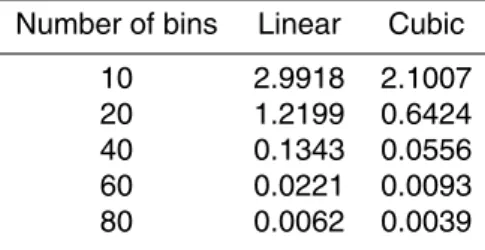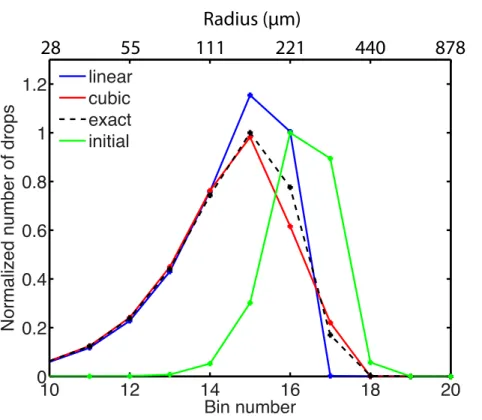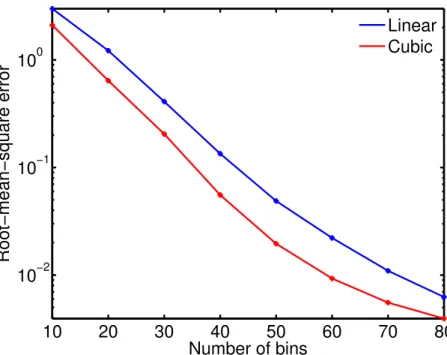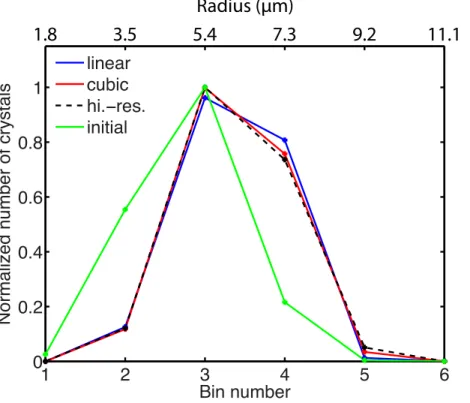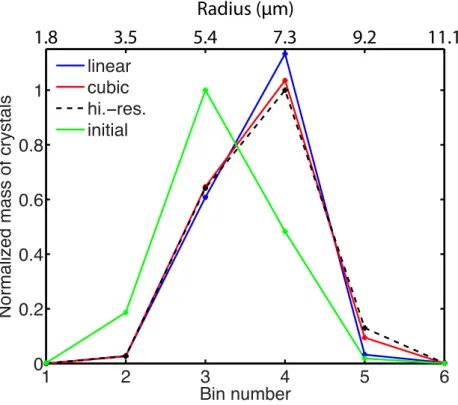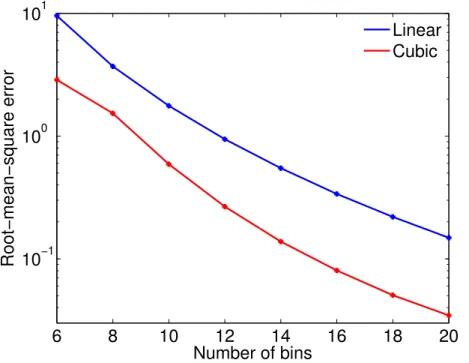ACPD
11, 21631–21654, 2011Hybrid bin scheme
T. Dinh and D. R. Durran
Title Page
Abstract Introduction
Conclusions References
Tables Figures
◭ ◮
◭ ◮
Back Close
Full Screen / Esc
Printer-friendly Version Interactive Discussion
Discussion
P
a
per
|
Dis
cussion
P
a
per
|
Discussion
P
a
per
|
Discussio
n
P
a
per
Atmos. Chem. Phys. Discuss., 11, 21631–21654, 2011 www.atmos-chem-phys-discuss.net/11/21631/2011/ doi:10.5194/acpd-11-21631-2011
© Author(s) 2011. CC Attribution 3.0 License.
Atmospheric Chemistry and Physics Discussions
This discussion paper is/has been under review for the journal Atmospheric Chemistry and Physics (ACP). Please refer to the corresponding final paper in ACP if available.
A hybrid bin scheme to solve the
condensation/evaporation equation
using a cubic distribution function
T. Dinh and D. R. Durran
Department of Atmospheric Sciences, University of Washington, Seattle, WA 98195, USA
Received: 20 July 2011 – Accepted: 22 July 2011 – Published: 1 August 2011
Correspondence to: T. Dinh (tradinh@uw.edu)
ACPD
11, 21631–21654, 2011Hybrid bin scheme
T. Dinh and D. R. Durran
Title Page
Abstract Introduction
Conclusions References
Tables Figures
◭ ◮
◭ ◮
Back Close
Full Screen / Esc
Printer-friendly Version Interactive Discussion
Discussion
P
a
per
|
Dis
cussion
P
a
per
|
Discussion
P
a
per
|
Discussio
n
P
a
per
|
Abstract
A computationally efficient method is proposed to replace the piecewise linear number distribution in a hybrid bin scheme with a piecewise cubic polynomial. When the linear distribution is replaced by a cubic, the errors generated in solutions to the condensa-tion/evaporation equation are reduced by a factor of two to three. Alternatively, using 5
the cubic distribution function allows reducing the number of bins by 20±5 % when solving the condensation/evaporation problem without sacrificing accuracy.
1 Introduction
In the microphysics context, a hybrid bin scheme is a two-moment explicit scheme designed to solve for the evolution of the size spectrum of cloud droplets and ice crys-10
tals. The particular hybrid bin scheme that is the focus of this paper is the scheme developed by Chen and Lamb (1994); hereafter referred to as the CL scheme.
The CL scheme has been implemented in meso- and synoptic-scale cloud resolving models, including the Nonhydrostatic Modeling System of the University of Wisconsin (Hashino and Tripoli, 2007) and the Goddard Cumulus Ensemble model (Przyborski, 15
2006). It has also been used in case studies of warm clouds (Kuba and Fujiyoshi, 2006; Kuba and Murakami, 2010), orographic clouds (Chen and Lamb, 1999), synoptically forced cirrostratus (Lin et al., 2005) and thin cirrus in the tropical tropopause layer (Dinh et al., 2010).
The CL scheme produces less numerical diffusion than one-moment bin schemes 20
and so is more accurate. Yet, because of its computational cost, it has not been im-plemented in 3-D or large-scale models. In the CL scheme, the evolution of two mo-ments (mass and number of particles) in each bin has to be evaluated, which can impose both computational and storage burdens in dynamically-coupled multidimen-sional cloud models.
ACPD
11, 21631–21654, 2011Hybrid bin scheme
T. Dinh and D. R. Durran
Title Page
Abstract Introduction
Conclusions References
Tables Figures
◭ ◮
◭ ◮
Back Close
Full Screen / Esc
Printer-friendly Version Interactive Discussion
Discussion
P
a
per
|
Dis
cussion
P
a
per
|
Discussion
P
a
per
|
Discussio
n
P
a
per
The CL scheme is based on a linear fit to the number distribution of microphysi-cal particles in each bin. In this paper, we show that replacing the linear distribution function by a cubic polynomial significantly reduces the error of the scheme in solving the condensation/evaporation equation. This new scheme can be used to increase accuracy, or can alternatively allow computations with fewer bins to obtain the same 5
accuracy. Such an increase in efficiency may be useful for modelers using hybrid bin schemes in cloud resolving models.
2 The hybrid bin scheme
2.1 Evolution of the number density
The evolution of the number density n=n(x,m,t) of microphysical particles (droplets
10
or crystals) is described by
∂n
∂t =−∇·(un)+ ∂
∂z(Vtn)− ∂
∂m(cn)+G (1)
wherex=(x,y,z) is the vector location in space,m is the particle mass andtis time.
The first term in Eq. (1) is advection in space by the velocity vectoru. The second term
is sedimentation of particles at the terminal fall speedVt. The third term is growth at
15
ratecby water vapor condensation onto droplets or deposition onto crystals. The last termGrepresents the aggregation process.
In a cloud resolving model, the changes inndue to the individual terms in Eq. (1) are computed separately and then summed together to give nat the next time step. Here we will concentrate on the condensation/deposition term only.
ACPD
11, 21631–21654, 2011Hybrid bin scheme
T. Dinh and D. R. Durran
Title Page
Abstract Introduction
Conclusions References
Tables Figures
◭ ◮
◭ ◮
Back Close
Full Screen / Esc
Printer-friendly Version Interactive Discussion
Discussion
P
a
per
|
Dis
cussion
P
a
per
|
Discussion
P
a
per
|
Discussio
n
P
a
per
|
2.2 Subgrid linear distribution
In the original CL scheme, the number densitynas a function of the mass of particles
min each bin is assumed linear and represented by
n(m)=n0+k(m−m0), (2)
and the total number and mass of particles in the bin are given as 5
N =
Zm2
m1
n(m)dm, M=
Zm2
m1
mn(m)dm, (3)
wherem1andm2are the masses that define the bin boundaries. Equations (2) and (3)
are consistent when
n0= N
△m, k=
12N(m−m0)
(△m)3 , (4)
wherem0=(m1+m2)/2,△m=m2−m1andm=M/N is the mean mass of the bin.
10
The distribution function given by Eqs. (2) and (3) may be negative in part of the bin. If that happens Chen and Lamb (1994) ensured positiveness by modifying the distribution so that it occupies only part of the bin. Ifn0+k(m1−m0)<0, they set
n(m)=
(
k∗(m−m∗) if m∗≤m≤m2,
0 otherwise, (5)
where1 15
m∗=3m−2m2, k∗=
2N (m2−m∗)2. 1
ACPD
11, 21631–21654, 2011Hybrid bin scheme
T. Dinh and D. R. Durran
Title Page
Abstract Introduction
Conclusions References
Tables Figures
◭ ◮
◭ ◮
Back Close
Full Screen / Esc
Printer-friendly Version Interactive Discussion
Discussion
P
a
per
|
Dis
cussion
P
a
per
|
Discussion
P
a
per
|
Discussio
n
P
a
per
Alternatively, ifn0+k(m2−m0)<0,
n(m)=
(
k∗(m−m∗) if m1≤m≤m∗,
0 otherwise, (6)
where
m∗=3m−2m1, k∗=− 2N (m1−m∗)2
.
2.3 Bin shift 5
LetN be the number of bins and µ1,µ2,...,µN+1 denote the grid divisions along the
mass axis. In both the original CL algorithm and our new method, the procedure to stepNj andMj forward in time for each binj involves growing the particles in the bin, shifting the bin along the mass axis and finally mapping the shifted bin onto the mass axis. The algorithm may be described by the following four steps:
10
1. The number and mass after one step of condensational/depositional growth in bin
j are calculated as ˜
Nj=Nj, ˜
Mj=Mj+Njc(mj)△t,
15
wherec(mj) is the growth rate at the mean massmj=Mj/Nj. For efficiency, all particles in the bin are assumed to grow at the rate of the mean mass of the bin.
2. The left and right boundaries of the shifted bin (m1,j andm2,j) are calculated as:
m1,j=µj+c(µj)△t, m2,j=µj+1+c(µj+1)△t,
ACPD
11, 21631–21654, 2011Hybrid bin scheme
T. Dinh and D. R. Durran
Title Page
Abstract Introduction
Conclusions References
Tables Figures
◭ ◮
◭ ◮
Back Close
Full Screen / Esc
Printer-friendly Version Interactive Discussion
Discussion
P
a
per
|
Dis
cussion
P
a
per
|
Discussion
P
a
per
|
Discussio
n
P
a
per
|
3. In the original CL scheme, the linear number distribution within each shifted bin is computed from ˜Nj, ˜Mj, m1,j andm2,j using Eqs. (2), (4), (5) and (6). The new procedure using the cubic distribution is discussed in the next section.
4. Find the location of the shifted bin with respect to the grid by comparing m1,j
andm2,j with the grid pointsµ1,µ2,...,µN+1. For each grid bin overlapped by the
5
shifted bin, integrate the distribution function of the shifted bin to find the number and mass of particles that will be accumulated in the grid bin. See Chen and Lamb (1994) for illustrations.
2.4 Subgrid cubic distribution
The slope of the linear distribution function in each bin does not depend on the distribu-10
tion in adjacent bins. As in higher-order finite volume methods, the distribution within in each bin can be more accurately estimated using information from adjacent bins. A cubic polynomial representing the number distribution in each bin can be evaluated using information from the bins immediately to the right and left (in addition to the total number and mass of the centered bin).
15
Chen and Lamb (1994) mentioned the possibility of using higher-order polynomial distributions that were continuous across bin boundaries. However, continuity at the bin boundary is not the optimal approach because, compared with other points along the mass axis within the bin, the boundaries of the bin are subject to the largest error. Indeed, the assumption that the growth rate of particles in the bin is equal to the growth 20
rate of the mean mass is least accurate at the bin boundaries. Thegrowth-of-the-mean assumption, though essential to the efficiency of the CL scheme, introduces large er-rors at the boundaries and occasionally causes the distribution to become negative there.
Hence, to derive the cubic form of the distribution for each bin, it is best to avoid 25
ACPD
11, 21631–21654, 2011Hybrid bin scheme
T. Dinh and D. R. Durran
Title Page
Abstract Introduction
Conclusions References
Tables Figures
◭ ◮
◭ ◮
Back Close
Full Screen / Esc
Printer-friendly Version Interactive Discussion
Discussion
P
a
per
|
Dis
cussion
P
a
per
|
Discussion
P
a
per
|
Discussio
n
P
a
per
distribution at the mean mass, denoted here byn, can be approximated by the linear form of the distribution, i.e. by evaluating Eqs. (2), (5) or (6) at the mean mass value.
Suppose that we represent the number distribution in each bin as the cubic
n(m)=a0+a1m+a2m2+a3m3. (7)
The coefficients a0,...,a3 are to be determined by the conservation of number and
5
mass (Eq. 3) in the centered bin, and by requiring that (mL,nL) and (mR,nR) from the
left and right bins satisfy Eq. (7). Here, we need to solve a system of linear equations for four coefficientsa0,...,a3for each bin.
An economical solution procedure can be obtained by rewriting the number distribu-tion as a weighted sum of the four lowest order Legendre polynomials, which are 10
P0(χ)=1, (8)
P1(χ)=χ , (9)
P2(χ)=
1 2(3χ
2
−1), (10)
P3(χ)=
1 2(5χ
3
−χ), (11)
15
whereχ is an independent variable defined between−1 and 1. A key property of the Legendre polynomials is the orthogonality condition,
Z1
−1
PjPkdχ= 2
2j+1δjk, (12)
whereδjk denote the Kronecker delta. If we defineχ as
χ=2(m−m0)
m2−m1
, (13)
ACPD
11, 21631–21654, 2011Hybrid bin scheme
T. Dinh and D. R. Durran
Title Page
Abstract Introduction
Conclusions References
Tables Figures
◭ ◮
◭ ◮
Back Close
Full Screen / Esc
Printer-friendly Version Interactive Discussion
Discussion
P
a
per
|
Dis
cussion
P
a
per
|
Discussion
P
a
per
|
Discussio
n
P
a
per
|
then asmvaries betweenm1andm2,χ varies between−1 and 1. Now the distribution
function can be written as a function ofχ:
n(χ)=b0P0(χ)+b1P1(χ)+b2P2(χ)+b3P3(χ). (14)
Based on the orthogonality property (Eq. 12), the conservation of number and mass (Eq. 3) simplifies to
5
N =△m
2
Z1
−1
(b0P0+b1P1+b2P2+b3P3)P0dχ
=b0△m,
M=△m
2
Z1
−1
(b0P0+b1P1+b2P2+b3P3)
m0P0+
△m
2 P1
dχ
=△m 2
2m0b0+△
m
3 b1
,
10
from which
b0= N
△m, (15)
b1=
6(M−m0N)
(△m)2 . (16)
Note that when b2=0 and b3=0, these values ofb0 and b1 are consistent with the
15
linear distribution function given by Eqs. (2) and (4).
Nextb2andb3are determined by requiring that (χ(mL),nL) and (χ(mR),nR) from the
left and right bins satisfy Eq. (14).χ(mL) andχ(mR) are Eq. (13) evaluated at the mean
ACPD
11, 21631–21654, 2011Hybrid bin scheme
T. Dinh and D. R. Durran
Title Page
Abstract Introduction
Conclusions References
Tables Figures
◭ ◮
◭ ◮
Back Close
Full Screen / Esc
Printer-friendly Version Interactive Discussion
Discussion
P
a
per
|
Dis
cussion
P
a
per
|
Discussion
P
a
per
|
Discussio
n
P
a
per
b0+b1χL+b2
3χ2L−1
2 +b3
5χ3L−3χL
2 =nL, (17)
b0+b1χR+b2
3χ2R−1
2 +b3
5χ3R−3χR
2 =nR, (18)
where
χL=χ(mL)=
2(mL−m0)
m2−m1
, χR=χ(mR)=
2(mR−m0)
m2−m1
.
5
Equations (17) and (18) are two linear equations of two unknowns (b2and b3), which
can be solved easily to obtainb2andb3.
Finally, the coefficients for the cubic distribution function in standard form are ob-tained by substituting Eqs. (8)–(11) and (13) into Eq. (14) and comparing with Eq. (7):
a0=b0−2qb1+
6q2−1
2
b2−
20q3−3qb3, (19)
10
a1=
2b1−12qb2+
60q2−3b3
△m , (20)
a2=
6b2−60qb3
(△m)2 , (21)
a3=
20b3
(△m)3, (22)
whereq= m0
△m.
15
ACPD
11, 21631–21654, 2011Hybrid bin scheme
T. Dinh and D. R. Durran
Title Page
Abstract Introduction
Conclusions References
Tables Figures
◭ ◮
◭ ◮
Back Close
Full Screen / Esc
Printer-friendly Version Interactive Discussion
Discussion
P
a
per
|
Dis
cussion
P
a
per
|
Discussion
P
a
per
|
Discussio
n
P
a
per
|
– The cubic distribution function obtains a negative minimum inside the bin, i.e., if
△=a22−3a1a3≥0
and forme=−
a2+√△
3a3 , we havem1≤me≤m2and
n(me)=a0+a1me+a2m2e+a3m3e<0.
– The cubic distribution function is negative at the left and/or the right bin bound-5
aries, which is the case if
n(m1)=a0+a1m1+a2m21+a3m31<0,
or
n(m2)=a0+a1m2+a2m22+a3m32<0.
The only modification to the bin-shift procedure outlined in Sect. 2.3 is in Step 3, 10
which is replaced by
3. Compute the cubic distribution function using Eqs. (15)–(22), and use this dis-tribution if it is nonnegative. Otherwise use the linear disdis-tribution. The linear distribution function should also be used for the leftmost and rightmost bins.
3 Numerical tests 15
3.1 Evaporation of cloud drops
ACPD
11, 21631–21654, 2011Hybrid bin scheme
T. Dinh and D. R. Durran
Title Page
Abstract Introduction
Conclusions References
Tables Figures
◭ ◮
◭ ◮
Back Close
Full Screen / Esc
Printer-friendly Version Interactive Discussion
Discussion
P
a
per
|
Dis
cussion
P
a
per
|
Discussion
P
a
per
|
Discussio
n
P
a
per
3.1.1 Initial conditions
For dilute and relatively large spherical drops, the condensational growth rate can be approximated by
c=dm
dt =BSm
1/3, (23)
whereS is the supersaturation ratio andB=4.7×10−8kg2/3s−1 under standard tem-5
perature and pressure.
The initial drop spectrum is assumed to be
f(m)=N0m
m2
c exp
−mm
c
, (24)
whereN0=2.0×10 8
m−3and mc is the mode of the distribution (wheref(m) is maxi-mum). We setmc=3.5×10−8kg, which is the mass of a drop whose radius is 200 µm. 10
The analytical solution to the evolution of the drop spectrum when the growth rate is given by Eq. (23) was derived by Tzivion et al. (1989). It is
n(m,t)=m−1/3X1/2fX3/2, (25)
whereX=m2/3−2
3BSt and f(X 3/2
) is the initial drop spectrum function evaluated at
X3/2. 15
Numerical solutions are computed for the case when drops evaporate at fixed S=
ACPD
11, 21631–21654, 2011Hybrid bin scheme
T. Dinh and D. R. Durran
Title Page
Abstract Introduction
Conclusions References
Tables Figures
◭ ◮
◭ ◮
Back Close
Full Screen / Esc
Printer-friendly Version Interactive Discussion
Discussion
P
a
per
|
Dis
cussion
P
a
per
|
Discussion
P
a
per
|
Discussio
n
P
a
per
|
3.1.2 Grid and time spacings
The grid points along the mass axisµj forj=1,2,...,N+1, whereN is the number of bins, are defined by
µj= 4 3ρπr
3
j,
rj=rminαj−1,
5
α=
r
max
rmin
1/N
,
wherermin=1 µm andrmax=1000 µm. The grid thus spans betweenrmin andrmaxand
is more tightly spaced for small radii. The time step is△t=1 s.
10
3.1.3 Results
Solutions for the evaporation problem at 20-bin-resolution at 50 min are shown in Fig. 1a (number of drops per bin) and b (mass of drops per bin). The solution obtained by the cubic scheme is more accurate than that by the linear scheme. In particular, the linear scheme underestimates the number and mass of larger drops (with major 15
errors in bin 17). At this resolution, the root-mean-square errors of the linear and cubic schemes are respectively 1.22×106m−3and 0.64×106m−3in cloud drop number and 6.34×10−2kg m−3and 2.29×10−2kg m−3in drop mass.
The errors of the solutions obtained by the linear and cubic schemes are given as a function of bin resolution in Table 1 and Fig. 2. At all but the coarsest resolution (10 20
ACPD
11, 21631–21654, 2011Hybrid bin scheme
T. Dinh and D. R. Durran
Title Page
Abstract Introduction
Conclusions References
Tables Figures
◭ ◮
◭ ◮
Back Close
Full Screen / Esc
Printer-friendly Version Interactive Discussion
Discussion
P
a
per
|
Dis
cussion
P
a
per
|
Discussion
P
a
per
|
Discussio
n
P
a
per
3.2 Depositional growth of small ice crystals
3.2.1 Initial conditions
If ice crystals are assumed spherical, the depositional growth rate can be calculated as
c=dm dt =
4πrSice
RvT esat,iceDv′+
Ls ka′T
L
s
RvT−1
(26)
5
(Pruppacher and Klett, 1978, p. 448), where m and r are respectively the mass and radius of ice crystals, Rv is the gas constant for water vapor, Ls is the latent heat of
sublimation,ka′ is the modified thermal conductivity of air,Dv′ is the modified diffusivity
of water vapor in air, esat,ice is the saturation vapor pressure over plane ice surface,
Sice is the supersaturation ratio with respect to ice andT is temperature. Here we will
10
consider the case of ice crystals in thin cirrus in the tropical tropopause layer, where typicallyp=100 mb andT=193 K.
The supersaturation ratio isSice=0.40 initially. In supersaturated condition,Sice will
decrease with time as water vapor is deposited onto ice crystals.
There is no analytical solution for this case. To evaluate the performance of the linear 15
and cubic schemes, numerical solutions obtained by these schemes at low resolution are compared with a numerical solution obtained by either of these schemes at high resolution. At high resolution both schemes converge to the same result, so either scheme can be used to obtain the high resolution solution.
The initial crystal spectrum is assumed to be Eq. (24), whereN0=5.0×105m−3and 20
ACPD
11, 21631–21654, 2011Hybrid bin scheme
T. Dinh and D. R. Durran
Title Page
Abstract Introduction
Conclusions References
Tables Figures
◭ ◮
◭ ◮
Back Close
Full Screen / Esc
Printer-friendly Version Interactive Discussion
Discussion
P
a
per
|
Dis
cussion
P
a
per
|
Discussion
P
a
per
|
Discussio
n
P
a
per
|
3.2.2 Grid and time spacings
The grid points along the mass axisµj forj=1,2,...,N+1, whereN is the number of bins, are defined by
µj= 4 3ρπr
3
j,
rj=rmin+α(j−1),
5
α=rmax−rmin
N ,
wherermin=0.3 µm and rmax=12 µm. rmax=12 µm is sufficiently large for this case
because during the simulation there is no ice crystal that grows to a radius larger than 12 µm. The grid thus spans betweenrmin and rmax and is equally spaced in terms of
10
radii of ice crystals. An equally spaced grid is possible in this case because the range of ice crystal sizes to be covered by the grid is narrow (between 0.3 µm and 12 µm).
The time step is△t=1 s.
3.2.3 Results
The supersaturation ratioSicedecreases from 0.40 at the initial time to 0.076 at 30 min.
15
Numerical solutions at 6-bin-resolution at 30 min are shown in Fig. 3a (number of crystals per bin) and b (mass of crystals per bin). The solution obtained by the cubic scheme is more accurate than that by the linear scheme. At this resolution, the root-mean-square errors of the linear and cubic schemes are respectively 9.57×103m−3 and 2.87×103m−3 in crystal number and 1.67×10−8kgm−3 and 0.50×10−8kgm−3 20
ACPD
11, 21631–21654, 2011Hybrid bin scheme
T. Dinh and D. R. Durran
Title Page
Abstract Introduction
Conclusions References
Tables Figures
◭ ◮
◭ ◮
Back Close
Full Screen / Esc
Printer-friendly Version Interactive Discussion
Discussion
P
a
per
|
Dis
cussion
P
a
per
|
Discussion
P
a
per
|
Discussio
n
P
a
per
The errors of the solutions obtained by the linear and cubic schemes are given as a function of bin resolution in Table 2 and Fig. 4. The errors of the cubic scheme are typically about a third of those of the linear scheme.
The error reduction due to the cubic scheme means that the number of bins can be reduced without sacrificing accuracy. For the same accuracy, the number of bins 5
required for the cubic scheme is 20±5 % less than that of the linear scheme. This is estimated as the difference in the intercepts of a horizontal line (whose value is the desired error) with the error curves of the cubic and linear schemes in Figs. 2 and 4.
4 Summary
We have presented a computationally efficient method to replace the piecewise linear 10
number distribution in the hybrid bin scheme originally developed by Chen and Lamb (1994) with a piecewise cubic polynomial. For models in which the CL scheme has been implemented, migrating from the linear distribution function to the cubic distribu-tion should be relatively simple.
When the original linear distribution is replaced by a cubic, the errors generated 15
in solutions to the condensation/evaporation equation are reduced by a factor of two to three. Alternatively, using the cubic distribution function would allow reducing the number of bins by 20±5 % when solving the condensation/evaporation problem without sacrificing accuracy.
High bin resolution may be required for other microphysical processes besides con-20
ACPD
11, 21631–21654, 2011Hybrid bin scheme
T. Dinh and D. R. Durran
Title Page
Abstract Introduction
Conclusions References
Tables Figures
◭ ◮
◭ ◮
Back Close
Full Screen / Esc
Printer-friendly Version Interactive Discussion
Discussion
P
a
per
|
Dis
cussion
P
a
per
|
Discussion
P
a
per
|
Discussio
n
P
a
per
|
References
Chen, J. P. and Lamb, D.: Simulation of cloud microphysical and chemical processes us-ing a multicomponent framework. Part I: Description of the microphysical model, J. Atmos. Sci., 51, 2613–2613, doi:10.1175/1520-0469(1994)051<2613:SOCMAC>2.0.CO;2, 1994. 21632, 21634, 21636, 21645
5
Chen, J. P. and Lamb, D.: Simulation of cloud microphysical and chemical pro-cesses using a multicomponent framework. Part II: Microphysical evolution of a wintertime orographic cloud, J. Atmos. Sci., 56, 2293–2312, doi:10.1175/1520-0469(1999)056<2293:SOCMAC>2.0.CO;2, 1999. 21632
Dinh, T., Durran, D. R., and Ackerman, T.: Maintenance of tropical tropopause layer cirrus, J. 10
Geophys. Res., 115, D02104, doi:10.1029/2009JD012735, 2010. 21632
Hashino, T. and Tripoli, G. J.: The spectral ice habit prediction system (SHIPS). Part I: Model description and simulation of the vapor deposition process, J. Atmos. Sci., 64, 2210–2237, doi:10.1175/JAS3963.1, 2007. 21632
Kuba, N. and Fujiyoshi, Y.: Development of a cloud microphysical model and parameteriza-15
tions to describe the effect of CCN on warm cloud, Atmos. Chem. Phys., 6, 2793–2810, doi:10.5194/acp-6-2793-2006, 2006. 21632
Kuba, N. and Murakami, M.: Effect of hygroscopic seeding on warm rain clouds - numeri-cal study using a hybrid cloud microphysinumeri-cal model, Atmos. Chem. Phys., 10, 3335–3351, doi:10.5194/acp-10-3335-2010, 2010. 21632
20
Lin, R.-F., Starr, D. O., Reichardt, J., and DeMott, P. J.: Nucleation in synoptically forced cirro-stratus,, J. Geophys. Res, 110, D08208, doi:10.1029/2004JD005362, 2005. 21632
Pruppacher, H. R. and Klett, J. D.: Microphysics of Clouds and Precipitation, D. Reidel Publish-ing Company, Dordrecht, Holland, 1978. 21643
Przyborski, P.: Goddard Cumulus Ensemble model, ONLINE, http://atmospheres.gsfc.nasa. 25
gov/cloud modeling/models gce.html, 2006. 21632
ACPD
11, 21631–21654, 2011Hybrid bin scheme
T. Dinh and D. R. Durran
Title Page
Abstract Introduction
Conclusions References
Tables Figures
◭ ◮
◭ ◮
Back Close
Full Screen / Esc
Printer-friendly Version Interactive Discussion
Discussion
P
a
per
|
Dis
cussion
P
a
per
|
Discussion
P
a
per
|
Discussio
n
P
a
per
Table 1.Root-mean-square errors in the number of drops (106m−3) of the solutions at 50 min
obtained by the linear and cubic schemes in the evaporation problem.
Number of bins Linear Cubic
ACPD
11, 21631–21654, 2011Hybrid bin scheme
T. Dinh and D. R. Durran
Title Page
Abstract Introduction
Conclusions References
Tables Figures
◭ ◮
◭ ◮
Back Close
Full Screen / Esc
Printer-friendly Version Interactive Discussion
Discussion
P
a
per
|
Dis
cussion
P
a
per
|
Discussion
P
a
per
|
Discussio
n
P
a
per
|
Table 2.Root-mean-square errors in the number of crystals (103m−3) of the solutions at 30 min
obtained by the linear and cubic schemes in the depositional growth problem.
Number of bins Linear Cubic
ACPD
11, 21631–21654, 2011Hybrid bin scheme
T. Dinh and D. R. Durran
Title Page
Abstract Introduction
Conclusions References
Tables Figures
◭ ◮
◭ ◮
Back Close
Full Screen / Esc
Printer-friendly Version Interactive Discussion
Discussion
P
a
per
|
Dis
cussion
P
a
per
|
Discussion
P
a
per
|
Discussio
n
P
a
per
10 12 14 16 18 20
0 0.2 0.4 0.6 0.8 1 1.2
Bin number
N
o
rma
lize
d
n
u
mb
e
r
o
f
d
ro
p
s
linear cubic exact initial
Radius (μm)
28
55
111
221
440
878
Fig. 1a. The analytical solution and numerical solutions obtained by the linear and cubic
ACPD
11, 21631–21654, 2011Hybrid bin scheme
T. Dinh and D. R. Durran
Title Page
Abstract Introduction
Conclusions References
Tables Figures
◭ ◮
◭ ◮
Back Close
Full Screen / Esc
Printer-friendly Version Interactive Discussion
Discussion
P
a
per
|
Dis
cussion
P
a
per
|
Discussion
P
a
per
|
Discussio
n
P
a
per
|
10 12 14 16 18 20
0 0.2 0.4 0.6 0.8 1 1.2
Bin number
N
o
rma
lize
d
ma
ss
o
f
d
ro
p
s
linear cubic exact initial
Radius (μm)
28
55
111
221
440
878
Fig. 1b. The analytical solution and numerical solutions obtained by the linear and cubic
ACPD
11, 21631–21654, 2011Hybrid bin scheme
T. Dinh and D. R. Durran
Title Page
Abstract Introduction
Conclusions References
Tables Figures
◭ ◮
◭ ◮
Back Close
Full Screen / Esc
Printer-friendly Version Interactive Discussion
Discussion
P
a
per
|
Dis
cussion
P
a
per
|
Discussion
P
a
per
|
Discussio
n
P
a
per
10 20 30 40 50 60 70 80 10−2
10−1 100
Number of bins
Root−mean−square error
Linear Cubic
Fig. 2. Root-mean-square errors in the number of drops (106m−3) of the solutions at 50 min
ACPD
11, 21631–21654, 2011Hybrid bin scheme
T. Dinh and D. R. Durran
Title Page
Abstract Introduction
Conclusions References
Tables Figures
◭ ◮
◭ ◮
Back Close
Full Screen / Esc
Printer-friendly Version Interactive Discussion
Discussion
P
a
per
|
Dis
cussion
P
a
per
|
Discussion
P
a
per
|
Discussio
n
P
a
per
|
1 2 3 4 5 6
0 0.2 0.4 0.6 0.8 1
Bin number
N
o
rma
lize
d
n
u
mb
e
r
o
f
cryst
a
ls
linear cubic hi.−res. initial
Radius (μm)
1.8
3.5
5.4
7.3
9.2
11.1
Fig. 3a.Numerical solutions obtained by the linear and cubic schemes at 30 min in the
ACPD
11, 21631–21654, 2011Hybrid bin scheme
T. Dinh and D. R. Durran
Title Page
Abstract Introduction
Conclusions References
Tables Figures
◭ ◮
◭ ◮
Back Close
Full Screen / Esc
Printer-friendly Version Interactive Discussion
Discussion
P
a
per
|
Dis
cussion
P
a
per
|
Discussion
P
a
per
|
Discussio
n
P
a
per
1 2 3 4 5 6
0 0.2 0.4 0.6 0.8 1
Bin number
N
o
rma
lize
d
ma
ss
o
f
cryst
a
ls
linear cubic hi.−res. initial
Radius (μm)
1.8
3.5
5.4
7.3
9.2
11.1
Fig. 3b. Numerical solutions obtained by the linear and cubic schemes at 30 min in the
ACPD
11, 21631–21654, 2011Hybrid bin scheme
T. Dinh and D. R. Durran
Title Page
Abstract Introduction
Conclusions References
Tables Figures
◭ ◮
◭ ◮
Back Close
Full Screen / Esc
Printer-friendly Version Interactive Discussion
Discussion
P
a
per
|
Dis
cussion
P
a
per
|
Discussion
P
a
per
|
Discussio
n
P
a
per
|
6 8 10 12 14 16 18 20
10−1
100
101
Number of bins
Root−mean−square error
Linear Cubic
Fig. 4. Root-mean-square errors in the number of crystals (103m−3) of the solutions at 30 min
